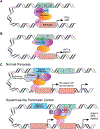Oncogenic super-enhancers in cancer: mechanisms and therapeutic targets
- PMID: 37059907
- PMCID: PMC10527203
- DOI: 10.1007/s10555-023-10103-4
Oncogenic super-enhancers in cancer: mechanisms and therapeutic targets
Abstract
Activation of oncogenes to sustain proliferative signaling and initiate metastasis are important hallmarks of cancer. Oncogenes are amplified or overexpressed in cancer cells and overexpression is often controlled at the level of transcription. Gene expression is tightly controlled by many cis-regulatory elements and trans-acting factors. Large clusters of enhancers known as "super-enhancers" drive robust expression of cell-fate determining transcription factors in cell identity. Cancer cells can take advantage of super-enhancers and become transcriptionally addicted to them leading to tumorigenesis and metastasis. Additionally, the cis-regulatory landscape of cancer includes aberrant super-enhancers that are not present in normal cells. The landscape of super-enhancers in cancer is characterized by high levels of histone H3K27 acetylation and bromodomain-containing protein 4 (BRD4), and Mediator complex. These chromatin features facilitate the identification of cancer type-specific and cell-type-specific super-enhancers that control the expression of important oncogenes to stimulate their growth. Disruption of super-enhancers via inhibiting BRD4 or other epigenetic proteins is a potential therapeutic option. Here, we will describe the discovery of super-enhancers and their unique characteristics compared to typical enhancers. Then, we will highlight how super-enhancer-associated genes contribute to cancer progression in different solid tumor types. Lastly, we will cover therapeutic targets and their epigenetic modulators.
Keywords: BRD4; Enhancer reprogramming; Epigenetic modulators; Mediator; Metastasis; Super-enhancers.
© 2023. The Author(s), under exclusive licence to Springer Science+Business Media, LLC, part of Springer Nature.
Conflict of interest statement
Figures



Similar articles
-
Selective inhibition of tumor oncogenes by disruption of super-enhancers.Cell. 2013 Apr 11;153(2):320-34. doi: 10.1016/j.cell.2013.03.036. Cell. 2013. PMID: 23582323 Free PMC article.
-
miR-766-5p Targets Super-Enhancers by Downregulating CBP and BRD4.Cancer Res. 2021 Oct 15;81(20):5190-5201. doi: 10.1158/0008-5472.CAN-21-0649. Epub 2021 Aug 5. Cancer Res. 2021. PMID: 34353856
-
Targeting the Epigenetic Reader ENL Inhibits Super-Enhancer-Driven Oncogenic Transcription and Synergizes with BET Inhibition to Suppress Tumor Progression.Cancer Res. 2024 Apr 15;84(8):1237-1251. doi: 10.1158/0008-5472.CAN-23-1836. Cancer Res. 2024. PMID: 38241700
-
Etiology of super-enhancer reprogramming and activation in cancer.Epigenetics Chromatin. 2023 Jul 6;16(1):29. doi: 10.1186/s13072-023-00502-w. Epigenetics Chromatin. 2023. PMID: 37415185 Free PMC article. Review.
-
Super-enhancers in cancer.Pharmacol Ther. 2019 Jul;199:129-138. doi: 10.1016/j.pharmthera.2019.02.014. Epub 2019 Mar 16. Pharmacol Ther. 2019. PMID: 30885876 Review.
Cited by
-
A novel super-enhancer-related risk model for predicting prognosis and guiding personalized treatment in hepatocellular carcinoma.BMC Cancer. 2024 Sep 2;24(1):1087. doi: 10.1186/s12885-024-12874-7. BMC Cancer. 2024. PMID: 39223584 Free PMC article.
-
Super-enhancers in hepatocellular carcinoma: regulatory mechanism and therapeutic targets.Cancer Cell Int. 2025 Jan 7;25(1):7. doi: 10.1186/s12935-024-03599-5. Cancer Cell Int. 2025. PMID: 39773719 Free PMC article. Review.
-
A heterodimer of hemoglobin identifies theranostic targets on brain-metastasizing melanoma cells.Int J Cancer. 2025 Aug 15;157(4):773-787. doi: 10.1002/ijc.35458. Epub 2025 Apr 26. Int J Cancer. 2025. PMID: 40285526 Free PMC article.
-
Illuminating the Noncoding Genome in Cancer Using Artificial Intelligence.Cancer Res. 2025 Jul 2;85(13):2368-2375. doi: 10.1158/0008-5472.CAN-25-0482. Cancer Res. 2025. PMID: 40261968 Free PMC article. Review.
-
Super enhancer lncRNAs: a novel hallmark in cancer.Cell Commun Signal. 2024 Apr 2;22(1):207. doi: 10.1186/s12964-024-01599-6. Cell Commun Signal. 2024. PMID: 38566153 Free PMC article. Review.
References
Publication types
MeSH terms
Substances
Grants and funding
LinkOut - more resources
Full Text Sources
Medical

